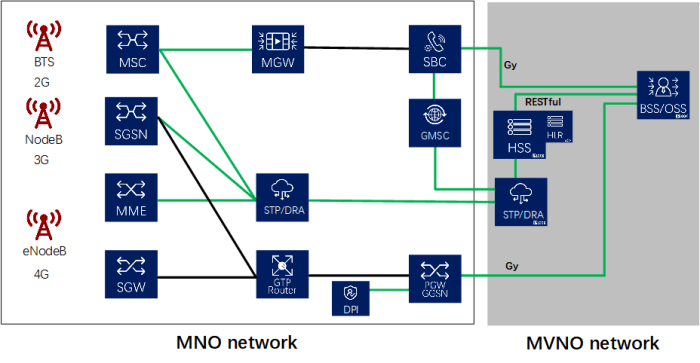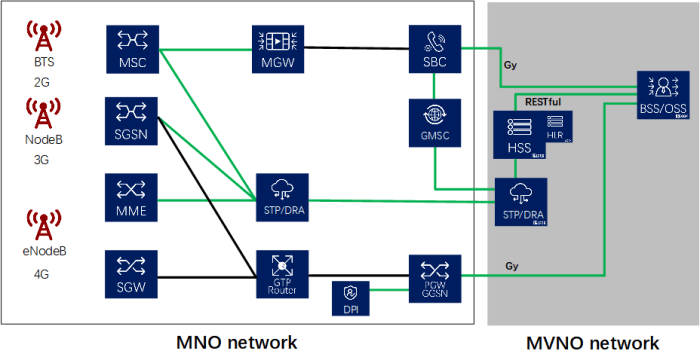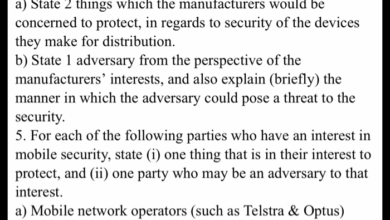Wireless Carriers Try Out MVNO Model A Deep Dive
Wireless carriers try out mvno model, a fascinating trend that’s reshaping the telecommunications landscape. MVNOs, or Mobile Virtual Network Operators, are essentially companies that lease network infrastructure from a larger carrier, allowing them to offer their own services and plans. This model presents exciting opportunities for both carriers and customers, but also potential challenges. We’ll explore the motivations, strategies, customer perspectives, and technological underpinnings behind this burgeoning model.
This exploration dives into the details of the MVNO model, covering its history, advantages, and disadvantages for both carriers and consumers. We’ll look at the different strategies carriers are using, the customer experience with MVNO services, and the technical considerations involved. The future of this model will be examined, along with the regulatory environment and potential market trends.
Introduction to MVNO Model: Wireless Carriers Try Out Mvno Model
The Mobile Virtual Network Operator (MVNO) model is a business approach where a company offers mobile services without owning its own network infrastructure. Instead, it leases network capacity and services from a larger telecommunications provider, known as the Mobile Network Operator (MNO) or parent carrier. This model allows MVNOs to focus on customer acquisition and service offerings, leveraging the existing infrastructure and network of the parent carrier.
It’s a dynamic approach that’s reshaping the telecommunications landscape, offering a diverse range of options to consumers.MVNOs operate by establishing a separate brand and marketing strategy, potentially targeting specific customer segments with tailored plans and services. They negotiate agreements with parent carriers to access network resources, and typically handle customer service and billing. The key relationship is one of partnership, with the MVNO relying on the parent carrier’s infrastructure for network connectivity, while the parent carrier gains access to new customer bases and potentially increased revenue through the MVNO’s operations.
Core Principles of MVNO Operations
MVNOs rely on agreements with parent carriers to utilize their network resources. This involves detailed contracts outlining access fees, service levels, and quality of service guarantees. Crucially, these agreements allow MVNOs to offer their own brand of service while benefiting from the established network of the parent carrier. This streamlined approach often results in lower capital expenditure for the MVNO, enabling them to focus on customer acquisition and marketing efforts.
Examples of MVNOs and Their Business Models
Several MVNOs operate globally, adopting diverse business models. For instance, some MVNOs focus on specific demographics, such as young adults, while others cater to particular needs like budget-conscious consumers. A prime example is a MVNO targeting students with discounted data plans, while another might focus on offering premium services with specialized features. Other MVNOs specialize in pre-paid options or offer a combination of contract and prepaid plans.
Historical Context and Evolution of the MVNO Model
The MVNO model emerged as a response to the growing need for competitive options in the telecommunications market. Initially, MVNOs leveraged the infrastructure of established carriers to offer lower-cost plans or specialized services. Over time, the model evolved to include a wider range of offerings, including customized plans and value-added services, driven by technological advancements and evolving consumer demands.
Technological advancements, like improved network capabilities and enhanced customer service technologies, played a key role in fostering the expansion of MVNO operations.
Key Advantages and Disadvantages of the MVNO Model
The MVNO model presents several advantages for both carriers and customers. For carriers, it facilitates expansion into new markets, attracting new customer segments, and generating incremental revenue without significant capital expenditure. For customers, MVNOs offer flexible and often cost-effective plans, potentially providing competitive pricing and unique value propositions.However, the model also has its disadvantages. MVNOs might face challenges in managing customer service and support effectively due to the reliance on the parent carrier’s systems.
Moreover, competition within the MVNO market can be fierce, making it crucial for MVNOs to maintain strong brand recognition and a competitive edge. There is a potential for reduced control over the network and services offered, which can impact service reliability or innovation.
Comparison of MVNOs and Traditional Carriers, Wireless carriers try out mvno model
| Feature | MVNO | Traditional Carrier |
|---|---|---|
| Pricing Structure | Often more competitive and flexible, with potentially lower base rates for certain plans. Can offer bundles or incentives for attracting customers. | Typically structured around contracts or monthly charges, often with varying price tiers for different levels of service. |
| Services Offered | May focus on specific needs or demographics, offering tailored plans, value-added services, or innovative products. | Typically provide a broader range of services, including voice, data, and specialized services. |
| Target Demographics | Can be highly specific, targeting particular segments such as students, families, or business professionals. | Generally target a wider range of customers, offering various plans to accommodate different needs and budgets. |
| Network Infrastructure | Relies on the network infrastructure of a parent carrier. | Owns and operates its own network infrastructure. |
This table highlights the key differences in pricing, services, and target markets between MVNOs and traditional carriers. The MVNO model often focuses on specific customer needs and budget-conscious segments, while traditional carriers provide a broader range of options.
Carrier Perspectives on MVNO Trials

Carriers are increasingly exploring the MVNO (Mobile Virtual Network Operator) model, a strategy that allows them to expand their reach and revenue streams without significant capital expenditure on network infrastructure. This approach presents both exciting opportunities and potential challenges. Understanding these nuances is crucial for assessing the viability and success of this evolving market dynamic.The motivations behind carriers’ interest in MVNO trials are multifaceted.
They seek to diversify their revenue streams, potentially unlocking new customer segments and market share. The flexibility offered by MVNOs allows carriers to experiment with pricing strategies and services, adapting to evolving consumer demands.
Motivations Behind MVNO Trials
Carriers are drawn to MVNOs due to the potential for revenue diversification. Existing customers may be attracted to lower-cost plans offered by MVNOs, while new customers might be reached by specialized service offerings. This diversification can lessen reliance on traditional, often saturated, markets. Furthermore, MVNO partnerships can be a testing ground for new technologies and services, reducing the risk associated with substantial investment in new infrastructure.
Potential Risks and Challenges
MVNO trials come with their own set of challenges. Maintaining brand image and reputation is critical. If an MVNO partner struggles, the carrier’s reputation could suffer. Ensuring service quality and reliability, often a key differentiator, is crucial to customer satisfaction. Regulatory hurdles and competition from other MVNOs can also present difficulties.
Managing the technical aspects of integrating different networks can also be a significant challenge. Finally, the complexities of revenue sharing agreements and managing the operations of multiple entities must be carefully considered.
Wireless carriers are experimenting with the MVNO model, which allows them to offer services without owning the entire network infrastructure. This is particularly interesting given Clearwire’s recent announcement to commence broadband wireless internet, clearwire to commence broadband wireless internet , suggesting a shift towards more flexible and potentially competitive wireless options. Ultimately, this trend of MVNOs could disrupt the traditional telecom landscape, forcing existing carriers to adapt.
Strategies to Manage MVNO Risks
Carriers are employing various strategies to mitigate the risks associated with MVNO trials. Strong due diligence and meticulous selection of MVNO partners are paramount. Clear service level agreements (SLAs) are essential to ensure consistent quality and address potential issues promptly. Transparency in communication with customers is vital for maintaining trust and managing expectations. Investing in robust customer support infrastructure is key to addressing any issues that arise.
Finally, continuous monitoring and evaluation of the MVNO partnership are essential to identifying and rectifying any problems early.
Potential Benefits for Carriers
The benefits of MVNO partnerships for carriers are substantial. Revenue diversification is a significant advantage, enabling carriers to generate additional income streams. This can bolster overall financial performance and allow carriers to expand into new markets more rapidly. The partnerships can also help carriers access a broader customer base, potentially reaching underserved segments. The ability to experiment with new services and technologies without large upfront investments can lead to faster innovation cycles.
Comparison of Carrier Strategies
Different carriers employ varied strategies in implementing the MVNO model. Some focus on niche markets, targeting specific customer segments with tailored offerings. Others adopt a broader approach, partnering with a variety of MVNOs to maximize market penetration. The approach also depends on the carrier’s existing infrastructure and technological capabilities. Some carriers may have a more established, comprehensive platform for managing partnerships, whereas others may be more experimental.
Revenue Streams from MVNO Partnerships
| Revenue Stream | Description |
|---|---|
| Wholesale Revenue | The carrier receives a fee for providing network access to the MVNO. |
| Revenue Sharing | The carrier receives a percentage of the MVNO’s revenue, based on agreed-upon terms. |
| Data Usage Fees | The carrier charges for data usage by MVNO customers. |
| Service Bundling | Offering bundled services that include both carrier and MVNO offerings, generating revenue through bundled pricing. |
Customer Perspectives on MVNO Trials
MVNOs, or Mobile Virtual Network Operators, are rapidly gaining traction as a viable alternative to traditional wireless carriers. Understanding customer perspectives is crucial for their success. Customers are increasingly seeking value and flexibility in their mobile plans, and MVNOs offer a potential path to achieving those goals. This section delves into customer perspectives on MVNO trials, exploring potential benefits, drawbacks, influencing factors, and the overall customer experience.
Potential Benefits and Drawbacks of MVNO Services
Customers often find MVNOs appealing for their competitive pricing. Lower monthly costs can be a significant advantage for budget-conscious consumers. Furthermore, the flexibility offered by MVNOs, often allowing for more granular control over data usage and calling minutes, can appeal to those seeking tailored plans. However, customers may also experience drawbacks. Potential network performance issues, particularly in areas with limited coverage, can be a significant concern.
Customer support quality can also vary between MVNOs and traditional carriers. Some MVNOs may offer limited or less comprehensive customer support options.
Factors Influencing Customer Choice Between MVNOs and Traditional Carriers
Several factors influence customer decisions when choosing between MVNOs and traditional carriers. Price is a major consideration. Customers frequently compare data plans, voice calling rates, and overall value propositions. Network coverage is another critical factor. Customers need a reliable signal for uninterrupted communication.
Furthermore, customer service quality plays a significant role. Easy access to support, fast response times, and effective resolution of issues are highly valued. Finally, the reputation and brand recognition of the carrier, either traditional or MVNO, often influence customer preference.
Differentiation Strategies of MVNOs
MVNOs are differentiating themselves in the market by focusing on niche customer segments. Some MVNOs target students or young professionals with specific data plans optimized for social media usage or streaming. Others target small businesses with bundled plans tailored for their needs. Specific value propositions, such as discounts for specific services like music streaming, are employed to attract customers and maintain a competitive edge.
Furthermore, many MVNOs are focusing on enhanced customer support channels, providing additional ways for customers to reach out and resolve issues.
Customer Experience with MVNOs
Customer experience with MVNOs varies widely. Service quality is often a concern. While some MVNOs maintain high service quality, others may face challenges in delivering a consistent and reliable experience. Pricing models, while often attractive, can be complex and may require careful consideration by the customer. Network performance, especially in areas with limited coverage, is a key concern.
Customers must ensure the MVNO’s network is reliable in their geographic area.
Potential Pain Points for Customers
Customers may experience difficulties with roaming services. Understanding roaming policies and potential additional charges is crucial. Furthermore, a lack of familiarity with MVNOs, combined with the complexity of certain plans, can lead to customer confusion. Limited device compatibility with MVNO networks can also be a source of frustration. Moreover, potential concerns regarding customer support access and resolution times are important considerations.
Customer Demographics and MVNO Preference
| Demographic Group | Preference for MVNO Services |
|---|---|
| Young Adults (18-25) | High preference for data-heavy plans and social media focused bundles |
| Students | High interest in affordable data plans for academic needs |
| Budget-Conscious Consumers | Strong interest in cost-effective plans with limited extras |
| Small Business Owners | Interest in business-focused bundles and integrated communication tools |
| Rural Residents | Concerned about network coverage and reliability |
The table above illustrates potential customer demographics and their associated preferences. Understanding these preferences can help MVNOs tailor their offerings and target specific customer segments effectively.
Technological Aspects of MVNO Trials
The MVNO model hinges on a sophisticated interplay of technology, agreements, and partnerships. Understanding the underlying technological infrastructure is crucial for successful implementation and operation. A robust and efficient technological foundation allows for seamless integration with parent carriers’ networks, optimized billing systems, and enhanced customer experience.The technical intricacies of MVNO trials are often underestimated. From network sharing to security protocols, careful consideration of technological aspects is paramount for both the parent carrier and the MVNO.
Successful trials require not only a robust technical infrastructure but also a clear understanding of potential challenges and the strategies to address them.
Technology Infrastructure Required for MVNO Operations
The technology infrastructure supporting MVNO operations is complex and multifaceted. It needs to accommodate the unique needs of the MVNO while seamlessly integrating with the parent carrier’s network. This includes dedicated network access points, robust billing and customer relationship management (CRM) systems, and security measures to protect sensitive data. The scale and complexity of this infrastructure will vary depending on the size and scope of the MVNO’s operations.
Network Sharing Agreements and Technology Partnerships
Network sharing agreements are essential for MVNO operations. These agreements dictate how the MVNO accesses the parent carrier’s network infrastructure. Key considerations include bandwidth allocation, service level agreements (SLAs), and the technical specifications for network integration. Strong technology partnerships between the parent carrier and the MVNO are crucial for successful trials. These partnerships ensure compatibility, streamlined processes, and efficient problem-solving.
Wireless carriers experimenting with the MVNO model are subtly chipping away at privacy fears, though not always in the most transparent ways. This shift towards mobile virtual network operators is a fascinating development, as it potentially offers consumers more choice and flexibility, but the implications for data collection and usage practices are still unclear. Understanding how these changes impact user privacy is crucial, as highlighted in the article on chipping away at privacy fears.
Ultimately, the future of wireless carriers relies on addressing these concerns while maintaining consumer trust.
For example, a partnership might involve the joint development of specific network features to enhance the MVNO’s offerings.
Technical Challenges in Integrating MVNO Networks
Integrating MVNO networks with parent carriers’ networks can present technical challenges. These challenges include ensuring seamless roaming capabilities, maintaining consistent service quality across networks, and managing network traffic efficiently. Issues such as varying network protocols, different billing systems, and security standards can also cause problems. Careful planning, thorough testing, and proactive problem-solving are vital to overcome these obstacles.
Careful consideration of network management systems is also needed to ensure optimal performance and maintain a high level of service quality.
Key Technologies for Billing and Customer Management
Efficient billing and customer management are critical for MVNO success. Core technologies include automated billing systems, robust customer relationship management (CRM) software, and data analytics platforms. These technologies enable accurate and timely billing, personalized customer service, and effective marketing campaigns. Data analytics also plays a significant role in understanding customer preferences and improving services. The use of APIs (Application Programming Interfaces) for seamless integration between different systems is also crucial.
Network Security in MVNO Models
Network security is paramount in MVNO models. Security protocols need to protect sensitive customer data and prevent unauthorized access to the network. Strong encryption, secure authentication procedures, and robust intrusion detection systems are essential components. Compliance with industry standards and regulations is also a critical factor. For instance, the use of multi-factor authentication (MFA) can strengthen security measures.
Technical Specifications and Requirements for a Successful MVNO Deployment
A successful MVNO deployment requires careful planning and adherence to specific technical specifications. The table below Artikels key requirements.
| Category | Specification/Requirement |
|---|---|
| Network Access | Clear network access agreements with the parent carrier, including bandwidth allocation and SLAs. |
| Billing System | Robust and scalable billing system compatible with the parent carrier’s system. |
| Customer Management | Comprehensive CRM system for managing customer profiles, interactions, and service requests. |
| Security | Implementation of strong encryption, secure authentication, and intrusion detection systems. |
| Integration | Seamless integration of MVNO systems with parent carrier’s network and billing infrastructure. |
| Scalability | Scalable infrastructure to accommodate future growth and increasing customer base. |
Market Trends and Forecasts
The MVNO (Mobile Virtual Network Operator) market is experiencing significant growth, driven by increasing demand for flexible and cost-effective mobile services. This dynamic landscape presents both opportunities and challenges for established carriers and emerging players alike. Understanding the current market trends, projected growth, and influencing factors is crucial for navigating this evolving sector.The MVNO model, offering a flexible and often cost-effective alternative to traditional mobile services, has gained substantial traction.
This is fueled by the desire for tailored plans, a wide array of services, and competitive pricing, which are changing the way consumers approach mobile communication. Forecasting the future trajectory of the MVNO market demands an in-depth analysis of the factors influencing its growth or decline.
Current Market Trends
The MVNO market is characterized by a growing number of players, innovative service offerings, and a constant pursuit of differentiation. Carriers are leveraging technology to improve customer experience and tailor services to specific demographics and needs. This is evident in the increasing adoption of data-rich plans, bundled services, and personalized customer support.
Growth Potential in Different Regions
The growth potential of the MVNO market varies significantly across regions. Emerging markets often present higher growth rates due to the presence of a large, underserved population seeking affordable mobile connectivity. Mature markets, however, may see slower but more stable growth, driven by competitive pricing strategies and the pursuit of niche customer segments.
Factors Driving Growth or Decline
Several factors are driving the growth of MVNOs. The key drivers include competitive pricing, flexible service plans, and a focus on customer-centric approaches. Conversely, regulatory hurdles, network infrastructure limitations, and the need for strong brand recognition can hinder MVNO adoption. Furthermore, the ability to secure reliable and affordable network access is a critical factor.
Emerging Technologies and Trends
Emerging technologies, like 5G and IoT (Internet of Things), are transforming the mobile landscape and presenting new opportunities for MVNOs. 5G’s enhanced speed and capacity are expected to enable new applications and services, while IoT connectivity will expand the potential for connected devices and services. This opens new avenues for MVNOs to innovate and cater to specific customer needs.
Wireless carriers are experimenting with the MVNO model, offering a fascinating glimpse into the future of telecom. This approach, which allows for greater flexibility and potentially lower costs, is certainly worth watching. The success of this model, however, hinges on a robust and secure system for managing contracts and transactions, which is where electronic signatures like electronic signatures the proof is in the process come into play.
Ultimately, the MVNO model’s long-term viability will depend on its ability to adapt to evolving consumer needs and secure transactions efficiently.
Competitive Landscape and Potential Disruption
The competitive landscape is highly dynamic, with established carriers and emerging MVNOs constantly vying for market share. New entrants, often with innovative business models and a focus on specific customer segments, can disrupt the existing order. Factors such as technological advancements, innovative business strategies, and regulatory changes are constantly reshaping the competitive landscape.
Market Share Projections (Next 5 Years)
| Region | Projected MVNO Market Share (2024-2028) |
|---|---|
| North America | 20-25% |
| Western Europe | 15-20% |
| Asia Pacific | 25-30% |
| Latin America | 10-15% |
| Africa | 5-10% |
Note: These projections are estimates and may vary depending on market conditions and technological advancements.
Regulatory Landscape and Impact
The regulatory environment plays a crucial role in shaping the success of Mobile Virtual Network Operators (MVNOs). Navigating the complexities of different national regulations is vital for MVNOs to establish a solid foothold in the market and avoid costly mistakes. Varying regulations across countries can significantly impact the MVNO model’s viability and profitability.The regulatory environment for MVNOs is multifaceted, encompassing licensing requirements, interconnection agreements, spectrum allocation, and consumer protection laws.
Different countries approach these aspects with varying degrees of stringency, sometimes hindering or accelerating the growth of MVNOs. Understanding these regulations is paramount for potential MVNOs to make informed decisions about entering a new market.
Regulatory Hurdles and Incentives for MVNO Trials
MVNO trials often face specific hurdles related to licensing procedures. These trials might require unique licenses or special permissions that traditional mobile operators do not need. Interconnection agreements between MVNOs and their parent mobile network operators (MNOs) must be meticulously crafted and approved. Negotiating these agreements can be challenging, especially when considering the various potential conflicts of interest.Furthermore, the regulatory framework can either encourage or discourage the adoption of the MVNO model.
Some countries provide incentives, such as streamlined licensing procedures or preferential spectrum allocation, to foster competition and innovation in the telecommunications sector. Conversely, stringent regulations or complex licensing processes can create barriers for MVNOs to enter the market.
Role of Government Policies and Regulations
Government policies heavily influence the MVNO market. Favorable policies that promote competition and innovation, such as reducing licensing fees or providing clear guidelines for MVNO operations, create a more favorable environment. Conversely, policies that stifle competition or place undue burdens on MVNOs can hinder market growth. For example, overly strict interconnection rules could raise operational costs, making it harder for MVNOs to compete effectively.Countries that proactively encourage MVNOs can gain significant benefits.
This includes fostering innovation in the mobile telecommunications sector, creating new job opportunities, and driving economic growth. The potential benefits are significant for consumers, as MVNOs often offer more competitive pricing and tailored services.
Potential Legal Issues and Compliance Requirements
MVNOs must adhere to various legal requirements. These range from consumer protection laws, data privacy regulations, and fraud prevention measures to ensure the provision of quality services. A common issue is ensuring compliance with data protection regulations, especially those related to personal data handling. Any violation of these regulations could lead to significant penalties.MVNOs must also be aware of the specific regulations related to the handling of financial transactions, especially those related to international payments.
This is critical when considering the international reach of MVNO operations. Failure to comply with these requirements can have severe legal and financial consequences.
Impact of Regulatory Changes on the MVNO Market
Changes in the regulatory landscape can have a profound impact on the MVNO market. New regulations or policy shifts can create opportunities for certain MVNOs while potentially making the market less attractive for others. For example, a new policy requiring MVNOs to use specific technologies could favour certain MVNOs with existing infrastructure. Likewise, changes to interconnection agreements can significantly impact the profitability of MVNOs.
Key Regulations and Guidelines for MVNO Operations in Major Markets
| Country | Key Regulations | Licensing Requirements | Interconnection Rules |
|---|---|---|---|
| United States | Federal Communications Commission (FCC) rules | Various licenses depending on services | Specific agreements between MNOs and MVNOs |
| European Union | European regulations on telecoms | Licensing based on specific services | Interconnection rules vary by country |
| China | Ministry of Industry and Information Technology (MIIT) rules | Stringent licensing procedures | Well-defined interconnection agreements |
| India | Department of Telecommunications (DoT) rules | Specific licenses based on service type | Clear interconnection protocols |
Note: This table provides a general overview and is not exhaustive. Specific regulations and guidelines can vary significantly depending on the specific services offered by an MVNO and the jurisdiction.
Case Studies of MVNO Trials
MVNO trials, while offering potential for both carriers and customers, often face unique challenges. Examining successful and unsuccessful implementations provides valuable insights into the key drivers of success and failure, ultimately helping future MVNO ventures. This section delves into specific case studies, highlighting critical factors that influenced the outcomes.Successful MVNO trials often demonstrate a deep understanding of the target market and a well-defined value proposition.
This approach is crucial for attracting and retaining customers. Conversely, trials that falter typically exhibit a lack of clarity in their market strategy or struggle with operational complexities.
Successful MVNO Trials: A Deep Dive
Understanding the factors that lead to MVNO success requires analyzing the strategies employed by those who succeeded. Successful trials often leverage strong partnerships with their parent carriers, allowing for cost-effective access to infrastructure and network resources. This strategic alliance facilitates streamlined operations and reduces initial investment costs. Furthermore, a well-defined value proposition, often focused on specific customer segments, is vital.
This targeted approach can differentiate the MVNO from other competitors and establish a unique market position.
- Example: A successful MVNO trial might target a specific demographic, such as young adults, and offer tailored data bundles and services. This personalized approach can significantly increase customer satisfaction and loyalty.
- Another example: A focused approach on a particular niche market, like business travelers, might prove profitable. Offering competitive rates and international roaming options could be a game-changer.
Key Factors Contributing to Success
Successful MVNO implementations often involve careful planning and execution. A well-defined business strategy, strong partnerships, and a clear value proposition are crucial components. The selection of a suitable target market, aligned with the MVNO’s strengths and resources, plays a vital role. Finally, an effective marketing strategy, designed to reach the target market, is essential for brand recognition and customer acquisition.
- Strong Partnerships: Collaboration with a major carrier often provides cost advantages and access to established infrastructure.
- Clear Value Proposition: A well-defined value proposition that resonates with the target market, such as lower prices or specific features, can differentiate the MVNO and attract customers.
- Targeted Marketing: Effective marketing campaigns that target the specific needs and interests of the intended customer segment can lead to significant success.
Unsuccessful MVNO Trials: Lessons Learned
Trials that failed often encountered significant operational challenges or lacked a clear understanding of the market. A miscalculation of customer demand or inadequate operational capacity can lead to significant financial losses. In addition, a failure to differentiate the MVNO from other players in the market can result in a lack of customer interest.
- Inadequate Market Research: A lack of accurate market research can lead to an incorrect assessment of customer demand and needs. This can result in an MVNO failing to meet the market’s expectations, potentially leading to a poor reception.
- Operational Inefficiencies: Difficulties in managing customer support or network operations can negatively impact the MVNO’s ability to maintain service quality and customer satisfaction. A poorly managed customer service process can quickly turn customers away.
- Lack of Differentiation: Failure to offer a unique value proposition that sets the MVNO apart from existing competitors can lead to a lack of customer interest and market penetration.
Case Study Summary Table
| MVNO Trial | Carrier Partner | Target Market | Value Proposition | Outcome | Key Success/Failure Factors |
|---|---|---|---|---|---|
| Example MVNO 1 | Large Telecom Carrier A | Young Adults | Lower data costs, exclusive content | Success | Strong partnership, targeted marketing |
| Example MVNO 2 | Regional Telecom Carrier B | Business Travelers | Competitive international roaming | Failure | Inadequate network coverage, weak customer support |
Concluding Remarks

In conclusion, wireless carriers trying out the MVNO model is a significant shift in the telecommunications industry. While opportunities for revenue diversification and market expansion are enticing for carriers, managing risks and ensuring a positive customer experience is crucial. The model’s success will depend on effective strategies, customer satisfaction, and navigating the complex technological and regulatory landscapes. This trend is poised to reshape the mobile telecommunications market in the coming years.






